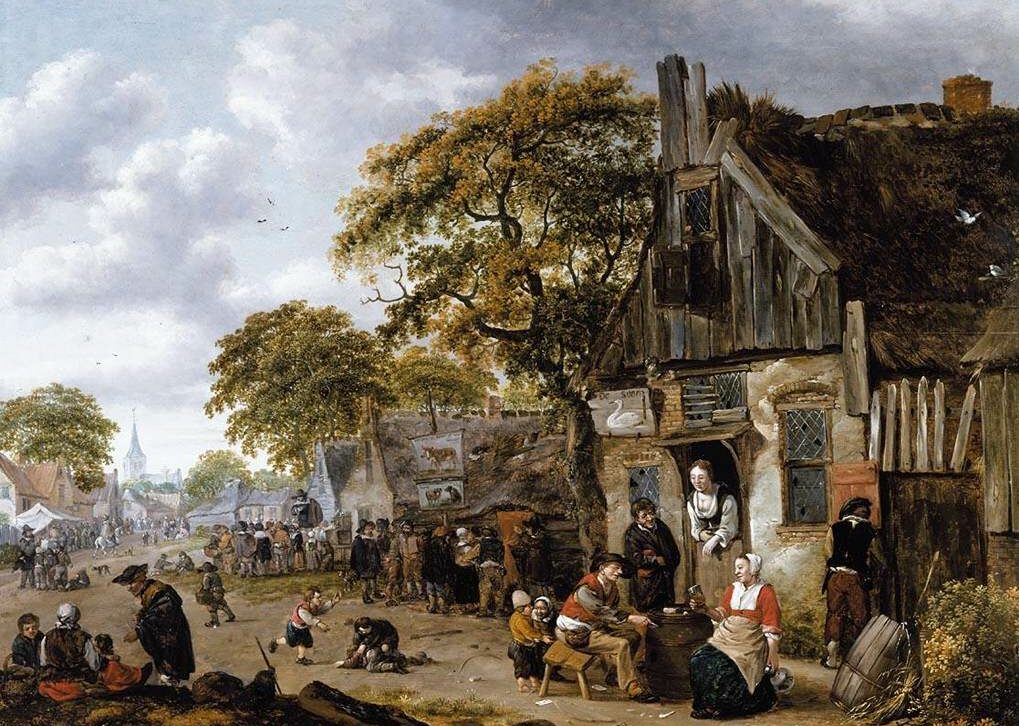Hillsborough, NC. Living in a suburban development of about 50 homes, I’m frequently surprised to learn that someone I’ve never seen before lives in a house a stone’s throw from mine. As far as modern subdivisions go, we actually have a great community dynamic, as there is a little playground that draws many of the young families together. But for the most part we remain, in the end, simply strangers briefly living next door to one another—not unlike the random collection of people you might encounter in line at a grocery store or on a subway train.
Revisiting Aristotle recently, I found myself reflecting on his vision of a naturally constituted human society. The philosopher first says that every community is “constituted for the sake of some good.” At the most basic, he says the smallest unit consists of “male and female, for the sake of reproduction.” According to Aristotle, this is not by choice, but, like in other plants and animals, due to the “natural striving to leave behind another that is like oneself.”
As this happens, a little community is formed around that good of reproduction, which we call the family. But then he describes how a few of these families bind together to form a village, usually starting as an extended family. The family satisfies daily needs, like preparing meals and having shelter and a place to sleep, while the village satisfies “non-daily needs,” like sharing vital skills and goods.
Then, many villages together would make up a “polis,” or a city, which he says is a “community of communities” drawn together for the good of achieving the good life. He also calls this a “complete community,” since it should approach “full self-sufficiency.”
One can think of the early neighborhoods in the polis of New York City as each operating as a village of sorts, typically made up of families connected by culture and religion. Not every village is directly connected to a larger polis, but it at least relies on a network of political and economic connections with other nearby villages.
Looking across time and space, it seems that Aristotle provides a fairly good summary of how human beings have operated, setting aside his views on women and slaves. It could describe the ancient city of Rome and all its neighborhoods or a Native American village that is connected to the larger “polis” of its tribal federation.
But one place it does not describe is the modern American subdivision.
Imagine that you are the first explorer to visit a particular Native American village centuries ago. If you made your presence known at one of the dwellings, it’s unlikely that the villager would say to you, “Sorry, I can’t help introduce you around. I’m new here and don’t really know any of the others.”
That would never happen because the community would undoubtedly be constituted in the natural way Aristotle described—with concentric circles of close relationships. But in my own neighborhood, and those of most Americans, that response would not be surprising. There are many in my “village” whose names I do not know and who I’ve only seen a time or two. Historically, that is odd, and it would have made most people severely uncomfortable to rest their head so close to another whose background, ethics, and aims are a mystery.
Our modern neighborhoods may appear somewhat like villages of other times and places, but this is only an artificial arrangement. It would be like if a man, woman, and two children lived together in a home, but they were all unconnected. They wouldn’t be a family, but some creepy replica missing a family’s commonly pursued good.
Modern households with no shared good can end up feeling this way, with each of the members going off to pursue their own aims. Returning, they can only robotically ask, “How was your day?”
This phenomenon is one reason some describe New Urbanist communities as “creepy.” New Urbanist development Seaside, Florida was chosen as the set for “The Truman Show” because it does such a good job at creating the material presentation of a community, while giving some the sense that it is not quite real. Good urbanism, and Seaside is a nearly perfect example, can certainly bring people together, but one must admit that the pattern of causation is a bit backwards.
Phillip Bess, in his important book, Till We Have Built Jerusalem, throws cold water on the aspirations of his fellow urbanists, saying that “something more than urban form is going to be required for a genuine renewal of traditional urbanism. To what extent do the realities of contemporary life even allow for, let alone encourage, a new traditional architecture and urbanism?”
We may be able to build Mayberry architecturally, but if it didn’t arise from a real community pursuing a real common good, it would only be a theme park—just a soulless Frankenstein’s monster of urban form. Individualists living in these well-designed neighborhoods may appreciate their beauty, but they will only be lonely individualists mimicking life in a healthy human settlement, like the strangers sharing a home.
Aristotle describes a man of this kind, who does not belong to the natural family-village-polis model of community, as “either a beast or a god.” Those who lack the human refinement to successfully live in community are beasts, he says, and those who are “in need of nothing through being self-sufficient” must be something approaching gods.
We may be tempted to think we are more like gods, transcending our human nature through our science, technology, and social progress, no longer needing archaic forms of social connection. But is that how natural man—whether in a Medieval English village, a Native American tribe, or even a New York City ethnic enclave of 100 years ago—would see us?
Why do we find it so difficult to create healthy, lifelong marriages? Why do over 100,000 people in the US die per year of drug overdoses? Why are mental health problems spiking? Why are loneliness, friendlessness, and involuntary childlessness all steadily rising? Something in our social model has fallen far short.
So while our ancestors certainly would be very impressed by our godlike technological abilities, they likely would not attribute our lack of natural community to that alone. They would see a lot of beastly qualities in us as well.
Bess argues the answer to all of this is to return to Natural Law and Aristotle’s vision of communities pursuing goods together—goods more vital to our identity than landscaping in the common areas. As an urbanist architect, he of course thinks human-scale, mixed-use neighborhoods with places of symbolic prominence saved for buildings that represent those goods (schools, churches, etc), are the key. I tend to agree.
But this would involve us creating opportunities to really rely on those around us, rather than solely on the less-personal forces of big business and government. It could look like a group of friends choosing to live within walking distance and dedicating themselves to building a school for their children, or to cooperatively farm land, or to engaging in common worship, or all of the above. Such shared daily aims would give one real reason to get to know those they share space with.
Genuine community only arises when we need one another, and to the extent that we can fool ourselves into thinking we’re self-sufficient, we will find ourselves living in Frankenstein communities as beastly demigods, doomed to forever contrive chitchat or wave awkwardly to people who will always remain largely strangers.
Image via Wikipedia: Salomon Rombouts, “A Village Street Scene,” 17th c.





1 comment
Brian
“these well-designed neighborhoods”
Paging Jane Jacobs…
One wonders what would have happened in an alternate universe where WWII never happened, and so when people gained access to cars and wanted to move out of cities, the government didn’t have the money, power, or authority to obliterate cities and impose the freeway system over the previous road network, and development had to happen more piecemeal and organically.
No new “design” scheme, no matter how well intentioned, can undo the catastrophe of Urban Renewal. The mindset is the same–“here’s the big plan that will fix everything!” Nope. If that’s the mindset, then it’s a certainty it’s never going to work, no matter what else follows.
Comments are closed.